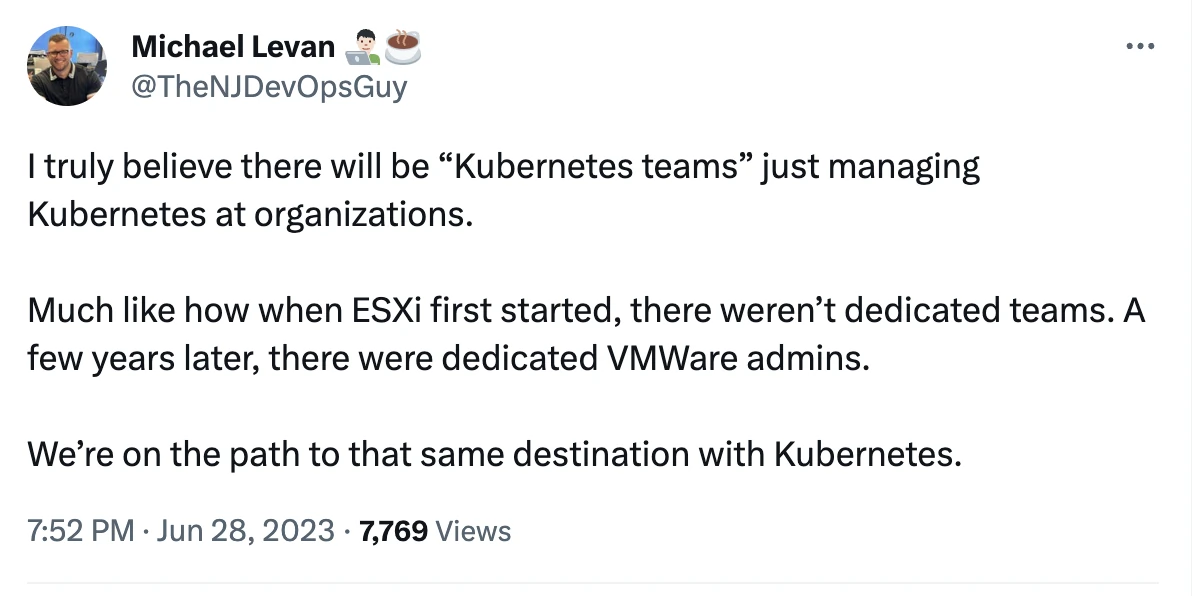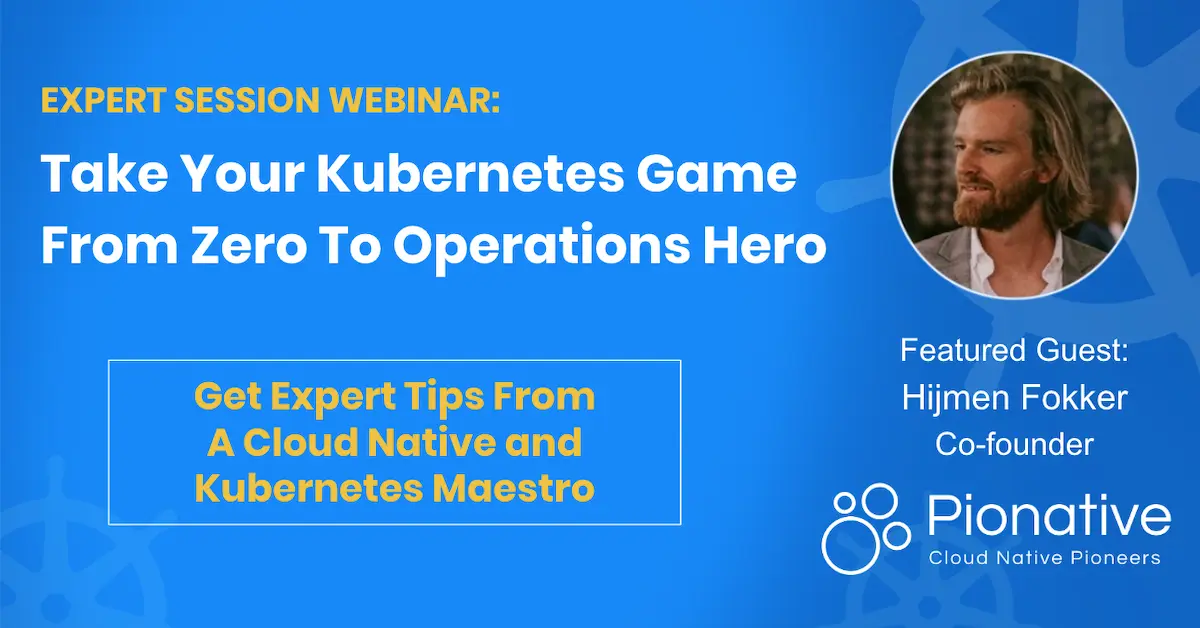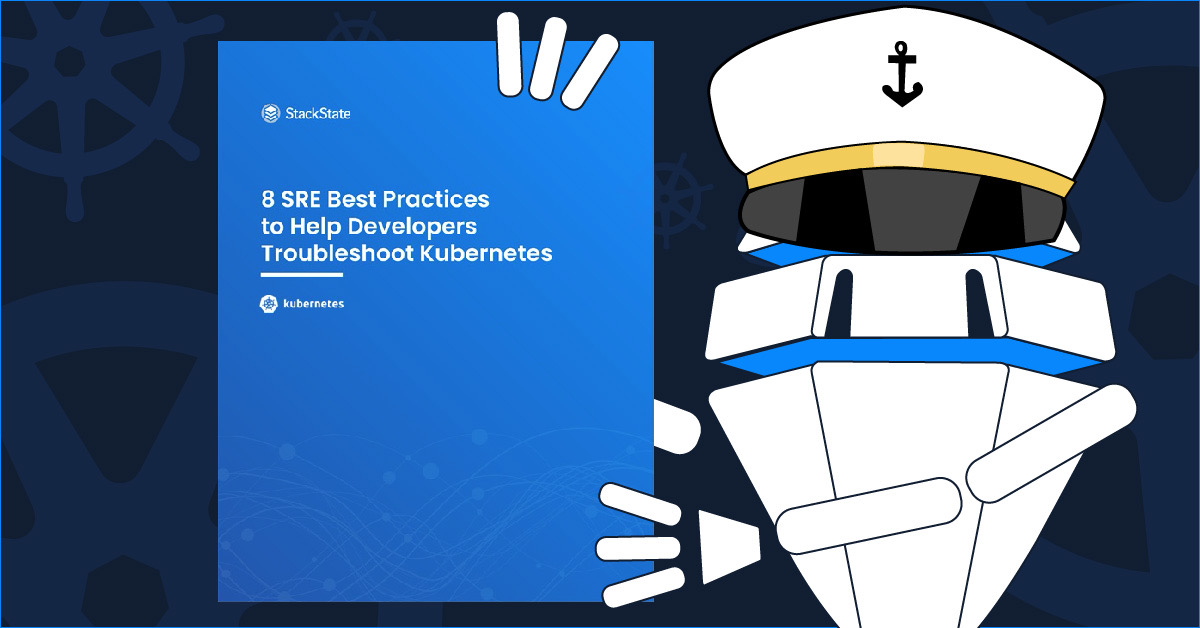In the ever-evolving landscape of enterprise technology, certain milestones mark the transition from innovation to recognition by early adopters to widespread adoption. Gone are the days when Kubernetes was just a segmented buzzword or something only the tech-savvy companies played with. Today, it's a force to be reckoned with, and we need to take a closer look at what it means for us.
Giving credit where credit is due, this blog post draws inspiration from this thought-provoking tweet by Michael Levin , prompting us to delve into the current state of Kubernetes adoption and the profound impact it’s having on businesses worldwide.

Dangerous dragon or a magnificent treasure?
We all agree that Kubernetes has emerged as a powerful tool for orchestrating containerized applications. However, depending on how the adoption is supported in the organization, Kubernetes can resemble a double-edged sword, capable of becoming either a dangerous dragon or a magnificent treasure. And sometimes, as it goes through different phases of adoption, it can manifest both qualities simultaneously.
Michael's tweet got me thinking about our experiences onboarding StackState's Kubernetes troubleshooting solution with our own customers. Platform adoption isn't as simple as choosing one model over another. From what we're seeing, it typically begins with implementation within smaller groups and gradually expands to encompass all clusters and teams across the organization.
Join us as we uncover five distinct skill levels of Kubernetes users — from beginners taking their first steps, to skilled troubleshooters tackling challenges head-on, to pioneers pushing the boundaries of what Kubernetes can achieve. With expert advice, tools and tips, we'll show how our innovative troubleshooting solutions empower teams at every stage of an organization's transformative Kubernetes journey.
5 Types of Kubernetes Users
Kubernetes users can be classified into five different skill levels, each representing a unique stage of proficiency. These levels reflect the diverse range of expertise and experience within the community, each with different needs, challenges and opportunities.
1 - The Newbies
Companies that are new to Kubernetes are starting from scratch, building the foundation of their Kubernetes infrastructure.
The initial focus is on getting the technology up and running, with a strong emphasis on the platform. Next up, they’ll embrace a little automation, infrastructure as code and take some initial steps towards observability. Once they have the basics down, they start diving deeper into the inner workings of Kubernetes, and that's when things get challenging.
Common issues that Newbies often encounter revolve around setting up Kubernetes properly. Here are some examples:
Accidentally exposing internal services to the internet: This is a common security mistake that can occur if teams fail to configure network policies correctly.
Using the 'latest' tag: Deploying container images with the 'latest' tag can result in unexpected changes and breakages. It's best to use specific version tags instead.
Invalid YAML structure: Kubernetes objects are defined using YAML, and an invalid YAML structure can lead to deployment failures. Teams should verify that their YAML is properly formatted and validated.
The good news is that you're not alone in facing these hurdles. Many other Newbies have walked the same paths before and overcome similar challenges. As a result, valuable resources are available to assist, helping you build a well-functioning Kubernetes layer where applications can be effectively deployed.
Pro Tip: Don't try to reinvent the wheel. Take advantage of stacks that work. Companies like Pionative and Spectro Cloud offer Kubernetes solutions that can help you get started and avoid common pitfalls.
How StackState helps: StackState can assist Newbies by providing instant observability out of the box. Our solution helps developers understand service and infrastructure dependencies to effectively troubleshoot applications in production even if they didn't build them.
2 - The Heroes
Next up, the expert teams who know what's going on. Heroes are often the platform teams who've already navigated their way through Cloud v1 and are now packaging all those learnings into v2. Don't get too comfortable, though. Since they're responsible for managing and troubleshooting the platform simultaneously, there are plenty of opportunities to trip up. In fact, Heroes can often be their own K8s bottleneck.
Here are some common issues Heroes might face:
Incorrect use of labels and selectors: Labels and selectors are used to group K8s objects together, and misusing them can cause issues with deployments and scaling.
Giving too many privileges to containers: Overextending container privileges can increase the risk of security breaches. They should only have the minimum privileges necessary to perform their intended tasks.
Ignoring health checks: Like an annual physical exam, tech health checks are essential to keeping Kubernetes services running smoothly. Ignoring them can lead to service disruptions and downtime.
Pro Tip: To avoid bottlenecks, focus on the developer experience. Determine what your engineers need to troubleshoot issues and empower them with the right tools and knowledge to handle problems independently.
How StackState helps: We help Heroes reduce toil by assembling all the data required for frictionless troubleshooting. We correlate this data and contextually present it through dashboards, configurations, views, history, topology and service maps so teams can see precisely what matters most and act on it swiftly.
3 - The Optimizers
One step up from the Heroes are the Optimizers, who have a knack for extending tool usage beyond their own needs to cater to the engineering teams they support. But with so many tools out there, plenty of teams are still trying to figure things out on their own.
While Optimizers can independently troubleshoot problems themselves, they can still run into some issues. Here are just a few:
Poor resource management: Kubernetes offers flexible resource allocation, but ensuring efficient resource usage is often overlooked. Teams should monitor resource utilization and adjust resource requests and limits to avoid over or under-provisioning.
Lack of security measures: Like anything else, Kubernetes clusters can be susceptible to attack if not sufficiently secured. Adhere to best practices, implement role-based access control (RBAC) and network policies and regularly update K8s and its components to address any vulnerabilities.
Pro Tip: It's worth investigating developer portals, which play a key role in standardizing workflows by establishing golden paths and offering a unified interface for developers to access and manage resources.
How StackState helps: Use StackState to provide the Optimizer with the big picture, highlighting the services that require attention to set better thresholds and improve the accuracy of issue detection. This allows teams to tailor observability solutions to their specific needs, improving efficiency and reducing the time spent on troubleshooting.
4 - The Easy Riders
This is the team that, at first glance, has everything in place. Easy Riders are in control and make good use of tools like Kubecost and Slim.ai . They thrive with chaos engineering and love testing distributed systems to ensure they’ll withstand random disruptions. Best of all, they recognize that running a Kubernetes platform entails more than just enabling engineers to use it. Easy Riders empower others to go beyond the basics and aim higher.
Pro Tip: You already understand that Kubernetes is a means to an end. So where do you go from here? Have you considered serverless architectures? It might be the logical next step in your cloud-native journey.
How StackState helps: For the Easy Riders, StackState offers real-time alerts and notifications for external systems like Slack, PagerDuty and others. This feature allows expert teams to escalate critical issues and potentially improve incident response times — while always staying in control.
5 - The Discoverers
Finally, we have the Discoverers. These teams have mastered the art of deploying, maintaining and running their apps. It's almost like living on autopilot. But let’s not get too confident; this is precisely the moment to be proactive and stay curious. So, how will future technologies align with your business requirements? Or better yet, how will your business take advantage of what lies ahead?
Pro Tip: Celebrate being one of the frontrunners in the market. Your knowledge and experience are valuable assets that you should nurture. Continue to explore, learn and push the boundaries of what's possible with Kubernetes.
How StackState helps: For the Discoverers, StackState can assist with capturing and recasting expert knowledge into efficient, repeatable practices. Not only does this reduce the complexity of K8s, it effectively enables every engineer to meet increasingly challenging issues head-on. By streamlining troubleshooting, your teams are freed up to continuously innovate and do more with Kubernetes.
So, what is Kubernetes for you?
Are you still in the dangerous dragon stage? Or are you already experiencing the bounty of a magnificent treasure?
The more you evolve your skills and tame the beast, the more value Kubernetes will bring to your organization. And with StackState, you’ll streamline tooling expenses and significantly reduce developer time by consolidating all data into a single, budget-friendly solution — a full stack observability platform that delivers cross-team clarity.
About StackState
StackState is designed to help engineers quickly identify and resolve issues in their Kubernetes-based applications. With features like real-time visualization, integrated out-of-the-box monitors, guided remediation and time travel capabilities, StackState provides a comprehensive solution to streamline Kubernetes troubleshooting and improve system reliability.
See for yourself in our live playground environment.
Or use your own data and try us for free to troubleshoot Kubernetes with ease.



